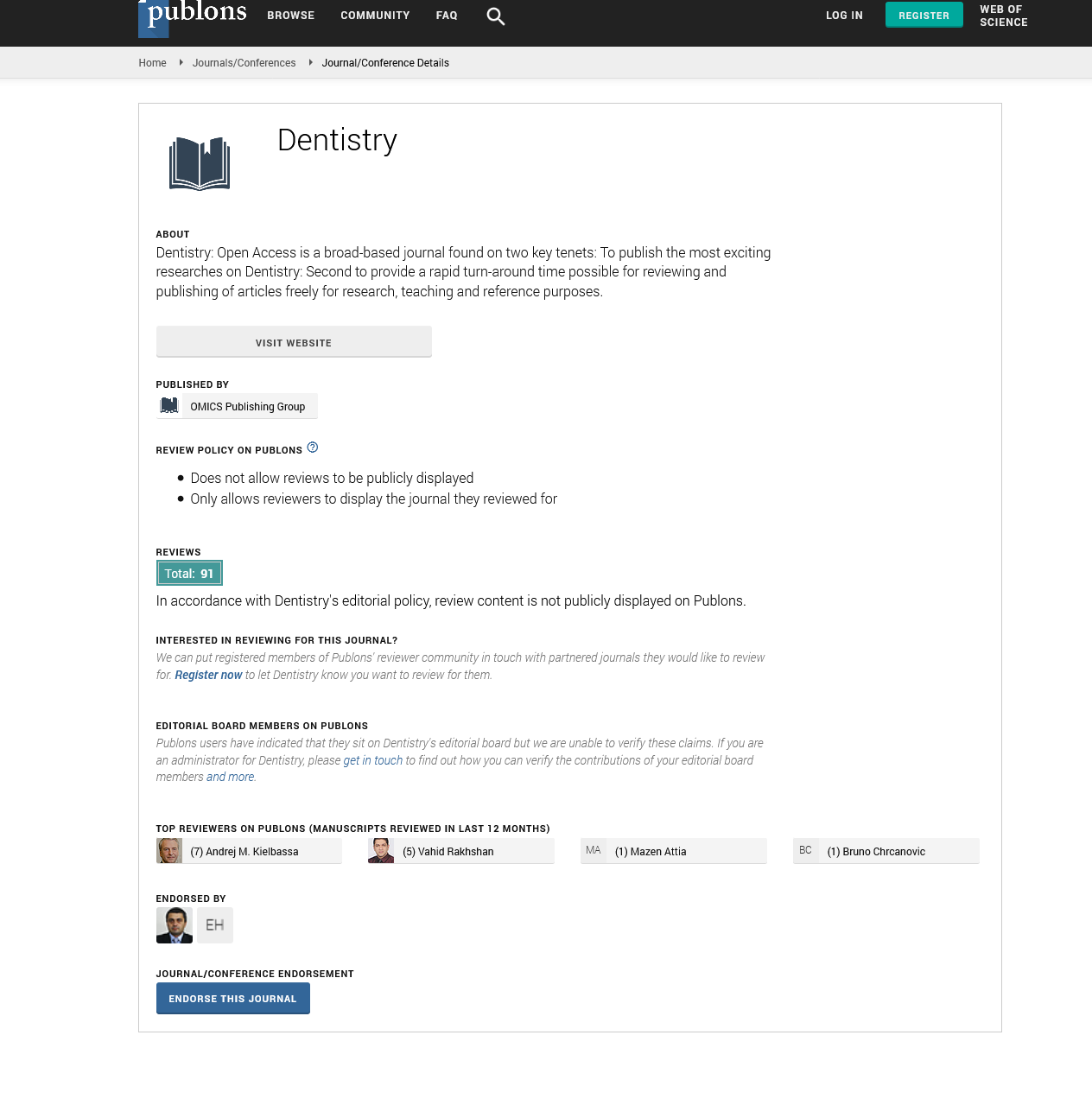Citations : 2345
Dentistry received 2345 citations as per Google Scholar report
Indexed In
- Genamics JournalSeek
- JournalTOCs
- CiteFactor
- Ulrich's Periodicals Directory
- RefSeek
- Hamdard University
- EBSCO A-Z
- Directory of Abstract Indexing for Journals
- OCLC- WorldCat
- Publons
- Geneva Foundation for Medical Education and Research
- Euro Pub
- Google Scholar
Useful Links
Share This Page
Journal Flyer

Open Access Journals
- Agri and Aquaculture
- Biochemistry
- Bioinformatics & Systems Biology
- Business & Management
- Chemistry
- Clinical Sciences
- Engineering
- Food & Nutrition
- General Science
- Genetics & Molecular Biology
- Immunology & Microbiology
- Medical Sciences
- Neuroscience & Psychology
- Nursing & Health Care
- Pharmaceutical Sciences
Commentary - (2025) Volume 15, Issue 1
Effect of Ceramic Concentrates on the Precision of 3D-Printed Crowns
Melisa Demirel*Received: 25-Feb-2025, Manuscript No. DCR-25-28550; Editor assigned: 27-Feb-2025, Pre QC No. DCR-25-28550 (PQ); Reviewed: 13-Mar-2025, QC No. DCR-25-28550; Revised: 20-Mar-2025, Manuscript No. DCR-25-28550 (R); Published: 27-Mar-2025, DOI: 10.35248/2329-9088.25.15.714
Description
Additive Manufacturing (AM) has brought significant advancements to the field of dentistry, offering an efficient and precise approach to fabricating dental restorations. One of the areas of growing interest is the accuracy and internal fit of crowns produced using resins modified with ceramic composite concentrates. These materials aim to improve the mechanical properties, aesthetic qualities and longevity of the restorations. The trueness and internal adaptation of such crowns play a significant role in their clinical performance, influencing factors such as retention, occlusal stability and long-term success.
Additive manufacturing in dental applications
The use of AM in dentistry has expanded due to its capability to create complex geometries with high precision. Unlike subtractive techniques, which often result in material wastage, AM allows for layer-by-layer fabrication, optimizing material usage and structural integrity. Various techniques, including Stereolithography (SLA), Digital Light Processing (DLP) and material jetting, are commonly employed for fabricating dental crowns.
Resin-based materials are frequently utilized in AM due to their favorable mechanical properties and ease of processing. The introduction of ceramic composite concentrates into these resins has aimed to enhance strength, wear resistance and biocompatibility. However, the accuracy and internal fit of such modified materials remain a subject of investigation.
Trueness in additive manufacturing
Trueness refers to the closeness of a fabricated object to its intended digital design. High trueness ensures that dental restorations exhibit proper fit, function and aesthetic integration with the surrounding dentition.
Material composition: The inclusion of ceramic fillers affects shrinkage, polymerization behaviour and overall accuracy.
Printing parameters: Layer thickness, exposure time and printing orientation impact dimensional accuracy.
Post-processing: Washing, curing and polishing procedures can introduce variations in final dimensions.
Studies assessing trueness typically employ optical scanning and digital superimposition techniques to compare printed crowns with their original digital models. Discrepancies are measured to determine the degree of deviation and potential areas requiring improvement.
Internal fit of crowns
The internal fit of a crown is a determinant of its clinical success, as it affects cementation, load distribution and marginal adaptation. Poor internal adaptation can lead to cement dissolution, microleakage and restoration failure.
Marginal gap: The space between the crown margin and the prepared tooth surface.
Axial gap: The space along the axial walls.
Occlusal gap: The space at the occlusal surface, which influences contact points and load-bearing capacity.
Ceramic-modified resins tend to exhibit different polymerization shrinkage patterns compared to conventional resin materials, which can affect internal fit. The balance between ceramic filler content and resin matrix plays a key role in determining how well the material adapts to the prepared tooth structure.
Factors affecting trueness and internal fit
Several elements contribute to variations in trueness and internal adaptation.
Material shrinkage: Polymerization shrinkage of resins containing ceramic fillers can lead to dimensional inaccuracies.
Layer thickness: Finer layers generally result in better detail reproduction but may increase fabrication time.
Printer calibration: Machine precision, laser power and exposure settings impact final accuracy.
Post-processing handling: Improper washing and curing can cause dimensional changes and surface irregularities.
Understanding these variables is necessary for optimizing the accuracy of crowns fabricated using ceramic-modified resins.
Comparative analysis with conventional methods
When compared to traditional milling techniques, AM offers distinct advantages in terms of material conservation and design flexibility. However, discrepancies in trueness and internal fit still present challenges. Some studies indicate that while AM restorations demonstrate comparable marginal adaptation to milled restorations, differences in internal fit are observed, often requiring adjustments during cementation.
Conventional milling processes generally provide higher accuracy due to the subtractive nature of fabrication, which avoids material shrinkage associated with polymerization. Nevertheless, AM continues to evolve, with advancements in printer resolution and material formulations progressively improving accuracy and internal adaptation.
Citation: Demirel M (2025). Effect of Ceramic Concentrates on the Precision of 3D-Printed Crowns. J Dentistry. 15:714.
Copyright: © 2025 Demirel M. This is an open-access article distributed under the terms of the Creative Commons Attribution License, which permits unrestricted use, distribution, and reproduction in any medium, provided the original author and source are credited.

